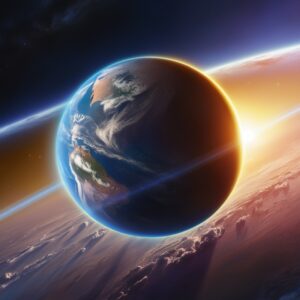- abaashishb7
- January 24, 2025
- 10:37 am
- No Comments
Exploring 5 Exoplanets
Exploring 5 Exoplanets That Feel Like Earth’s Cosmic Twins
Definition and Discovery
Exoplanets, or extrasolar planets, are planets that orbit stars beyond our solar system. Since the first confirmed discovery in 1992, thousands of these distant worlds have been identified, revealing a diversity of planets we once thought was unimaginable.
Importance of Studying Exoplanets
Understanding exoplanets provides insight into the formation of planetary systems, the uniqueness of Earth, and the potential for life elsewhere in the universe.
Criteria for Relatability
Key Factors Like Size, Temperature, and Water –
To be relatable to Earth, exoplanets are often judged based on their size, surface temperature, and the likelihood of liquid water, all of which are critical for supporting life as we know it.
Exploring 5 Exoplanets
The Concept of the “Habitable Zone”
The habitable zone, or the “Goldilocks zone,” is the region around a star where conditions might be just right for liquid water. Planets in this zone are prime candidates for exploration.
Exploring 5 Exoplanets
Artificial Intelligence Music Generator: Tune In
The 5 Most Relatable Exoplanets
1:- Kepler-452b: Earth’s “Cousin” in the Cosmos
Kepler-452b stands out as one of the most intriguing exoplanets identified, often dubbed “Earth’s cousin” due to its resemblances to our own planet. Discovered by NASA’s Kepler Space Telescope, it has offered researchers significant insights into the potential for habitable planets beyond our solar system.
Key Information About Kepler-452b
Distance from Earth: Roughly 1,400 light-years away.
Star System: It orbits a star known as Kepler-452, which shares similarities in size and temperature with our Sun.
Orbital Period: Kepler-452b completes an orbit in 385 Earth days, resulting in a “year” that closely resembles our own.
Size: The planet’s diameter is approximately 60% greater than that of Earth, categorizing it as a “super-Earth.”
Location: Kepler-452b is situated in the habitable zone of its star, where conditions may permit the presence of liquid water on its surface.
Exploring 5 Exoplanets
लोणार सरोवर इतिहास – उल्कापाताने घडवलेला ऐतिहासिक रत्न 2024
Earth-Like Characteristics
Habitable Zone
Kepler-452b is positioned within the habitable zone of its star, an area where temperatures are conducive to the existence of liquid water. This characteristic is essential for assessing potential habitability, making the planet an excellent candidate for further exploration.
Star Similarity
The star that Kepler-452b orbits, Kepler-452, closely resembles the Sun in terms of size, composition, and temperature. This similarity enhances the possibility that Kepler-452b could possess Earth-like environmental conditions.
Exploring 5 Exoplanets
Surface and Composition
Although direct observation of Kepler-452b’s surface is not possible, scientists hypothesize that it is likely a rocky planet due to its size and its position within the habitable zone. Its greater size may also suggest a stronger gravitational pull compared to Earth.
Exploring 5 Exoplanets
Atmosphere
The exact makeup of Kepler-452b’s atmosphere remains uncertain. Nevertheless, researchers theorize that it could possess a dense atmosphere capable of holding water and fostering a temperate climate.
Potential for Life
Kepler-452b’s placement in the habitable zone enhances the likelihood of life existing there. If the planet has water, a stable atmosphere, and the necessary chemical components, life could potentially thrive. However, its larger size may influence surface conditions, leading to increased gravity and higher atmospheric pressure.
Exploring 5 Exoplanets
Challenges to Study
Kepler-452b is located 1,400 light-years away, making direct study impossible with current technology. Future innovations, such as the James Webb Space Telescope, may offer deeper insights into its atmospheric composition and other features.
Exploring 5 Exoplanets
Why Kepler-452b Matters
The significance of Kepler-452b lies in its indication that Earth-like planets may be prevalent throughout the galaxy. Its discovery has motivated further exploration of similar planets and broadened our understanding of the conditions that could support life.
Kepler-452b is more than just a remote planet; it symbolizes the potential for discovering a new “home” in the cosmos and drives humanity’s pursuit of the profound question: Are we alone?
Exploring 5 Exoplanets

2:- Proxima Centauri b: The Nearest Exoplanet to Earth
Proxima Centauri b stands out as one of the most fascinating exoplanets identified to date. Situated within the Proxima Centauri star system, it holds the title of the closest known exoplanet to our planet and serves as a key subject for studies on habitability. Its nearness has positioned it as a central focus for scientific research and potential future missions.
* Key Information About Proxima Centauri b
Distance from Earth: Roughly 4.24 light-years.
Star System: Proxima Centauri, a red dwarf star and the nearest stellar companion to the Sun.
Orbital Period: Proxima Centauri b completes its orbit in approximately 11.2 Earth days.
Size: It has a mass about 1.17 times that of Earth, categorizing it as a “super-Earth.”
Location: The planet resides in the habitable zone of its star, where conditions may allow for the presence of liquid water.
Exploring 5 Exoplanets
Earth : The Blue Marble in Space (3)
* Features of Proxima Centauri B
Habitable Zone and Water Potential
Proxima Centauri B orbits within the habitable zone, where temperatures could permit liquid water to exist on its surface, making it a compelling candidate for the possibility of life.
* Size and Gravitational Effects
With a mass slightly exceeding that of Earth, Proxima Centauri B is likely to experience stronger gravitational forces. Its rocky composition is suggested by its size, although direct observations of its surface remain unattainable.
Exploring 5 Exoplanets
* Proxima Centauri: The Parent Star
Proxima Centauri is classified as a red dwarf star, significantly smaller and cooler than the Sun. This proximity to the star places the habitable zone closer, but red dwarfs are also known for their intense stellar flares, which can erode a planet’s atmosphere and impact its potential for habitability.
Exploring 5 Exoplanets
* Habitability Challenges
Stellar Activity
The frequent flares from Proxima Centauri can subject Proxima Centauri B to high levels of radiation, raising concerns about the planet’s ability to retain an atmosphere and support life. Tidally Locked Rotation
Proxima Centauri B may be tidally locked, which means that one hemisphere of the planet is perpetually oriented toward its star, while the opposite side remains in constant darkness. This phenomenon could lead to significant temperature variations and restrict the potential for habitability to a limited region between the two sides.
Exploring 5 Exoplanets
* Potential for Exploration
The close proximity of Proxima Centauri B to Earth makes it an attractive candidate for future exploration initiatives. Projects such as Breakthrough Starshot are designed to deploy small, high-velocity probes to the planet, potentially allowing for direct observations within a few decades.
* Significance of Proxima Centauri B
Proxima Centauri B offers humanity a unique opportunity to examine a potentially habitable exoplanet in detail. Its discovery has generated enthusiasm regarding the possibility of extraterrestrial life and has spurred advancements in space exploration technologies.
Exploring 5 Exoplanets
3:- TRAPPIST-1e: An Exciting Earth-Sized Exoplanet
TRAPPIST-1e is one of seven remarkable exoplanets that orbit the ultra-cool dwarf star TRAPPIST-1, situated approximately 39 light-years from our planet. This exoplanet stands out due to its Earth-like characteristics and its position within the habitable zone, where conditions may allow for the presence of liquid water.
* Key Information About TRAPPIST-1e
Distance from Earth: Roughly 39 light-years.
Star System: TRAPPIST-1, a red dwarf star that is smaller and cooler than our Sun.
Orbital Period: TRAPPIST-1e completes its orbit around the star in just 6.1 Earth days.
Size: It shares a similar size and mass with Earth, making it a prime candidate for possessing Earth-like features.
Location: The planet resides in the central region of the habitable zone of the TRAPPIST-1 system, where conditions may support liquid water.
Exploring 5 Exoplanets
* What Distinguishes TRAPPIST-1e?
Earth-Like Features
TRAPPIST-1e closely resembles Earth in terms of size, mass, and density. Among the seven planets in the TRAPPIST-1 system, it is the most Earth-like, characterized by a rocky surface that could potentially sustain liquid water.
Habitable Zone
Located within the habitable zone of its star, TRAPPIST-1e receives an optimal amount of energy, allowing for temperatures conducive to the existence of liquid water. This crucial aspect increases its likelihood of supporting life.
Exploring 5 Exoplanets
The TRAPPIST-1 System
The TRAPPIST-1 system is distinctive for containing seven Earth-sized planets, three of which lie within the habitable zone. These planets are closely packed, with orbital periods ranging from 1.5 to 12.4 Earth days, suggesting the possibility of interplanetary travel in the future.
Exploring 5 Exoplanets
Host Star: TRAPPIST-1
TRAPPIST-1 is an ultra-cool dwarf star with a significantly lower surface temperature compared to the Sun. This results in a habitable zone that is much nearer to the star, allowing TRAPPIST-1e to orbit at a distance that could provide stable temperatures. Potential for Life
TRAPPIST-1e possesses several features that position it as a promising candidate for the existence of life:
Stable Climate: A sufficiently dense atmosphere on TRAPPIST-1e could help maintain stable surface temperatures.
Rocky Composition: Its density, similar to that of Earth, indicates a solid surface that may allow for the presence of liquid water.
Moderate Radiation Levels: In contrast to many red dwarf stars, TRAPPIST-1 emits relatively low levels of harmful radiation, which is beneficial for potential life forms.
Challenges to Habitability
Atmospheric Loss: Due to its proximity to its star, TRAPPIST-1e may gradually lose its atmosphere as a result of stellar radiation.
Tidal Locking: Like many exoplanets orbiting red dwarfs, TRAPPIST-1e is likely tidally locked, resulting in one hemisphere perpetually facing the star, which could lead to significant temperature differences between the two sides.
Stellar Flares: While TRAPPIST-1 is generally stable compared to other red dwarfs, sporadic flares could still pose challenges to habitability.
Exploring 5 Exoplanets
Scientific Importance
TRAPPIST-1e is a key focus for the James Webb Space Telescope (JWST), which aims to investigate its atmospheric and surface conditions in depth. Through atmospheric analysis, researchers hope to identify indicators of water vapor, carbon dioxide, or even potential biosignatures.
Why TRAPPIST-1e Captures Attention
TRAPPIST-1e is a significant point of interest in the quest for extraterrestrial life. Its Earth-like dimensions, position within the habitable zone, and rocky nature make it one of the most intriguing exoplanets identified thus far. As technological advancements continue, TRAPPIST-1e may provide further insights into the conditions necessary for life and could serve as a key target for future interstellar missions.
Exploring 5 Exoplanets
4:- LHS 1140 b: A Super-Earth in the Habitable Zone
LHS 1140 b is an intriguing exoplanet situated within the habitable zone of the red dwarf star LHS 1140. Discovered in 2017, this rocky super-Earth has garnered significant attention from the scientific community due to its potential to support life-sustaining conditions. Its dense structure and proximity to Earth make it an ideal candidate for investigating exoplanetary atmospheres and their habitability.
Essential Information About LHS 1140 b
Distance from Earth: Approximately 49 light-years.
Star System: LHS 1140, a red dwarf star located in the constellation Cetus.
Orbital Period: LHS 1140 b completes an orbit around its star in 24.7 Earth days.
Size and Mass: It measures about 1.6 times the diameter of Earth and has a mass 6.6 times greater, categorizing it as a “super-Earth.”
Location: LHS 1140 b is positioned firmly within the habitable zone, where conditions may permit the presence of liquid water.
Exploring 5 Exoplanets
* Notable Features of LHS 1140 b
Rocky Structure
LHS 1140 b exhibits a density significantly greater than that of Earth, indicating a rocky core rich in iron. This characteristic positions it among the densest planets found within the habitable zones of red dwarf stars.
Atmospheric Possibilities
Preliminary studies indicate that LHS 1140 b may have preserved a substantial atmosphere. This is particularly noteworthy, as red dwarfs are known to often strip planets of their atmospheres due to intense radiation, especially during their formative years.
Exploring 5 Exoplanets
Host Star: LHS 1140
LHS 1140 is a relatively stable red dwarf star, exhibiting lower levels of stellar activity compared to its counterparts. This stability enhances the chances of LHS 1140 b maintaining a consistent atmosphere over time. Furthermore, the star’s cooler temperature and luminosity allow for closer planetary orbits without excessive heating, thereby broadening the habitable zone. Habitability Potential
Water and Climate
Positioned within the habitable zone, LHS 1140 b has the potential to support liquid water on its surface. If its thick atmosphere is confirmed, it could play a crucial role in regulating surface temperatures, fostering a stable climate that may be suitable for life.
Exploring 5 Exoplanets
Size and Gravity
The planet’s significant mass leads to a gravitational force that is stronger than that of Earth. While this increased gravity could pose challenges for life as we know it, it may also enhance the planet’s ability to retain its atmosphere over extended periods.
Challenges to Habitability
Stellar Radiation: Although LHS 1140 is less active than many red dwarfs, it still emits ultraviolet radiation that could affect the planet’s atmosphere.
Tidal Locking: LHS 1140 b may be tidally locked, resulting in one hemisphere being perpetually exposed to the star while the other remains in darkness. This could create extreme temperature variations, although atmospheric circulation might alleviate some of these effects.
Scientific Importance
Atmospheric Studies
LHS 1140 b presents an excellent opportunity for atmospheric research using advanced telescopes such as the James Webb Space Telescope (JWST). Researchers aim to identify gases like water vapor, carbon dioxide, or methane, which could suggest the presence of biological processes.
Exploring 5 Exoplanets
Search for Life
With its rocky composition and position in the habitable zone, LHS 1140 b is a leading candidate for exploring the conditions necessary for life. Discovering any biosignatures would significantly enhance our comprehension of the universe.
Why LHS 1140 b Matters
LHS 1140 b plays a vital role in the quest for habitable exoplanets. Its dense structure, possible atmosphere, and location within the habitable zone distinguish it from many other known exoplanets. It highlights the possibility that even the smallest stars can host planets with life-sustaining potential, broadening our perspective on where life may exist in the universe.
Exploring 5 Exoplanets
5:- Gliese 667 Cc: A Super-Earth in a Triple Star System
Gliese 667 Cc is an exoplanet situated within the intriguing Gliese 667 system, a triple-star formation located in the constellation Scorpius. This planet has garnered considerable interest due to its Earth-like features and its placement within the habitable zone of its star, making it a leading candidate in the quest for extraterrestrial life.
Essential Information About Gliese 667 Cc
Distance from Earth: Approximately 23.6 light-years.
Star System: It orbits Gliese 667 C, a red dwarf star that is part of the Gliese 667 triple-star system.
Orbital Period: Gliese 667 Cc completes its orbit around its star in 28 days.
Size and Mass: With a mass about 4.5 times that of Earth, it is classified as a “super-Earth.”
Location: The planet is located within the habitable zone of its host star, where conditions may permit the presence of liquid water.
Exploring 5 Exoplanets
Notable Features of Gliese 667 Cc
Position in the Habitable Zone
Gliese 667 Cc orbits centrally within its star’s habitable zone. Its distance from the cooler red dwarf star allows it to receive energy levels comparable to those Earth receives from the Sun, potentially fostering Earth-like environmental conditions.
Rocky Composition
Given its size and mass, Gliese 667 Cc is presumed to be a rocky planet with a solid surface, making it one of the more Earth-like exoplanets in terms of its structure and composition.
Exploring 5 Exoplanets
Host Star: Gliese 667 C
Gliese 667 C is a red dwarf star that is smaller and cooler than the Sun. It is the dimmest star in the Gliese 667 triple-star system. Its low brightness means that planets within its habitable zone must orbit much closer to the star, resulting in shorter orbital periods, such as the 28-day year of Gliese 667 Cc. Potential for Life
Exploring 5 Exoplanets
Surface Conditions
Gliese 667 Cc receives energy levels similar to those of Earth, which could facilitate a temperate climate if it possesses an appropriate atmosphere. Researchers theorize that liquid water may be present on its surface, a vital element for life as we understand it.
Atmospheric Retention
The planet’s increased gravity may enable it to maintain a denser atmosphere, potentially offering protection from harmful radiation and fostering a stable environment conducive to life.
Challenges to Habitability
Tidal Locking: Given its closeness to the host star, Gliese 667 Cc may be tidally locked, resulting in one hemisphere perpetually facing the star. This could lead to significant temperature fluctuations between the illuminated and dark sides, although a robust atmosphere might alleviate some of these extremes.
Stellar Activity: Red dwarf stars, such as Gliese 667 C, are known for their intense flares, which could erode a planet’s atmosphere or expose its surface to elevated radiation levels.
Exploring 5 Exoplanets
Scientific Importance
Gliese 667 Cc is regarded as one of the most promising exoplanets for investigating potential habitability. Its position within the habitable zone and relative proximity to Earth make it an attractive target for observation using advanced telescopes like the James Webb Space Telescope (JWST). Researchers aim to examine its atmosphere for biosignatures, such as oxygen or methane, which could suggest the existence of life.
Why Gliese 667 Cc Matters
Gliese 667 Cc is notable as one of the most Earth-like exoplanets identified to date. Its closeness to Earth and location within its star’s habitable zone render it a crucial candidate for exploring the conditions that may support life beyond our planet. Furthermore, its existence within a triple-star system offers a unique chance to investigate how such environments influence planetary formation and habitability.
Exploring 5 Exoplanets
The Impact of Technology on Exoplanet Research
Innovations such as the Kepler Space Telescope and the James Webb Space Telescope have significantly enhanced our capacity to identify and analyze these far-off planets, setting the stage for future breakthroughs.
Exploring 5 Exoplanets
The Importance of Exoplanets
Investigating exoplanets helps us gain insights into our own Earth, pursue the possibility of life beyond our planet, and expand the horizons of human understanding.
Exploring 5 Exoplanets
Final Thoughts
The study of exoplanets has reshaped our comprehension of the universe. These remote worlds not only ignite our curiosity but also offer the potential to address some of humanity’s most profound questions.
Exploring 5 Exoplanets Facebook





